Your business stands or falls by your success in bringing in new clients or sales, and that starts with leads.
If you’re making your first steps in the world of online sales and lead generation, this guide will help you make sense of it all.
See also: Guides to Content Marketing Strategy, Brand Awareness and Performance Marketing
In this article, we’ll cover:
- What leads are
- What lead generation is
- What the lead generation process is, and the key channels you need
- Why lead generation is crucial for your business to make sales
- How to calculate the cost of lead generation
We’ll also look at some proven lead-generation strategies and talk about the role of content in generating leads for your business.
By the end, you’ll understand the ins and outs of lead generation and be able to generate the leads you need to keep your business healthy and growing.
What are Leads?
In order to understand the topic of lead generation, it’s first crucial to understand what leads are. A lead is defined as a person with an interest in the product or service you’re selling, creating the possibility that they might become a customer.
This interest may be expressed by them interacting with your content or providing you with personal information about themselves.
What Is Lead Generation?
Lead generation is the process of using online-marketing strategies and tactics to identify and attract the people potentially interested in using your products or services. It is also known as online lead generation, or ‘lead gen.’
Once you have people’s attention, the goal is to convert that interest into action, so that some of these people become customers.
The success of any business depends on getting a steady stream of customers through its virtual or physical doors. It’s essential to learn lead generation to attract these customers and grow your business.
What is the Lead Generation Process?
Here’s how a lead-generation workflow operates, in a nutshell. The lead-generation marketing process first attracts leads, then turns those marketing leads into sales leads. This is sales-lead generation. The two processes are interwoven.
So, how do you move someone from being a lead to becoming a customer? To understand this, you need to know where lead generation fits into your sales and marketing funnel; what the key lead generation channels are; and how lead generation compares with other marketing tactics, such as raising brand awareness.
First, let’s talk about what a typical lead-generation workflow looks like. It’s usually portrayed as a funnel, which is a great way to visualize how people move from being unaware of you to eventually becoming customers. When you’re doing a funnel analysis the most important stages of a lead-generation funnel are often divided into:
- Awareness – when people first become aware of your brand. This stage is called top-of-funnel (TOFU)
- Consideration – when people look for solutions and evaluate your offering as a possibility. This stage is known as middle-of-funnel (MOFU)
- Decision – when people choose their solution – hopefully yours. This stage is known as bottom-of-funnel (BOFU)
Here’s an example from DigitalMarketer:
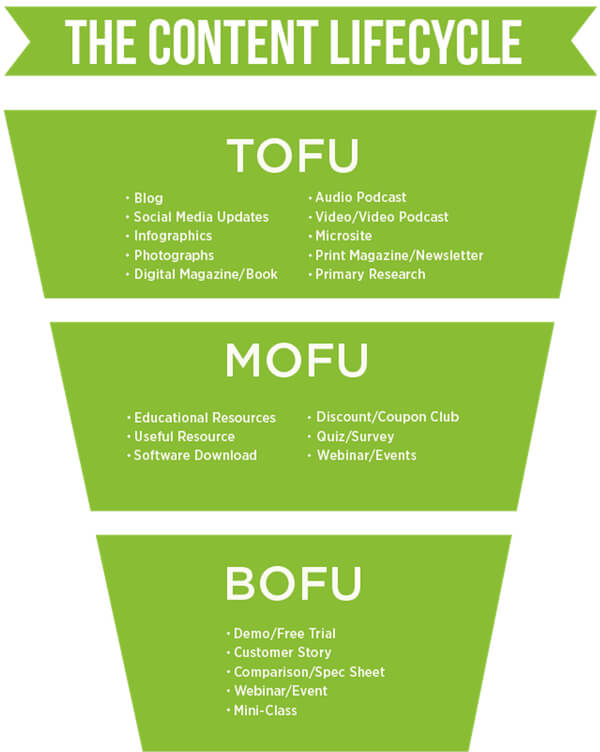
Sales Lead Generation Process
Think of it this way. Imagine there is a huge pool of people out there and they haven’t heard about you. You use some strategies to bring your business to their attention, such as paid Facebook campaigns, SEO, and content marketing. With these methods, they people to come to you, a form of inbound marketing.These strategies raise brand awareness, but the people looking at your business aren’t leads, yet.
For that to happen, they must engage with your business in some way, by subscribing to your email newsletter, for example, or by signing up for a webinar. Over time, you use other strategies to attract these people’s interest. Eventually, they start asking questions and taking actions that let you know that they’re becoming interested in buying. This is when they move from being marketing leads to sales leads.
This diagram from Lead Generation for Dummies illustrates this process:
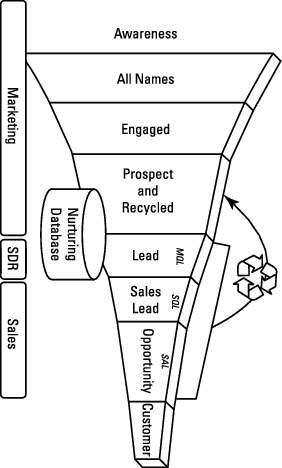
What Is The Importance of Lead Generation for Your Business?
Why are leads important, and why must you use online-lead generation techniques? Let’s answer the last question first. Your customers are online; they’re not waiting around for you to push information to them. They’re actively looking for the information they need.
Research from BazaarVoice shows that 45% of offline shoppers read reviews before buying. That rises to 56% for online shoppers.
This means that rather than just being online, you have to up your online game to get shoppers’ attention. You must:
- Make it easy for potential customers to find you
- Earn their trust
- Help them make buying decisions by providing valuable information so they choose you
The best way to do all of this is with content and paid distribution of that content. Give people something valuable and they’ll trade their email address for it. Once you have that email, you can nurture potential customers by continuing to offer value.
Plus, people only tend to buy after several interactions. Lead generation activities create those interactions that eventually generate sales.
Digital marketing and online-lead generation are continuous processes. They build trust by providing ever-increasing value, helping potential customers feel confident about buying from you.
How Much Does Lead Generation Cost?
Like other marketing, you have to think about numbers with lead-generation marketing, so customer acquisition cost (CAC) is crucial. It’s important to ensure that the amount you’re spending on lead generation brings in more in sales.
A simple formula for working out the CAC for your online-lead generation efforts is to divide your lead generation marketing spend by the number of new customers you acquire. If you spend $5,000 on a campaign and get 1,000 new customers, your CAC is $5.
Lead Generation Marketing: How to Get Started with Online Lead Generation
Developing a lead generation strategy isn’t easy — it requires knowing exactly how you’ll want to generate leads, strategies for doing so, lead generation tools to get the job done, and building campaigns to do so (examples for inspiration here).
But if you’re just diving in, we’re here to take you through exactly how to begin to generate leads online, step-by-step.
1. Buyer Personas
As with all marketing, before starting your next lead-generation campaign, you need to know who your customers are. The more specific you are, the more targeted you can be with your lead-generation tactics, and the more successful they will be.
The first step is to put together a buyer persona for your target customer. It’s OK to have more than one buyer persona. After all, someone buying men’s clothes is unlikely to have as great an interest in women’s clothes. Typically, buyer personas include:
- The age, gender and education level of your target customer
- Other demographic information, such as income level
- Interests
- Problems that you can solve with your product or service
- Anything that might stop them from wanting to buy
- And much more
You can find some of this information in Google Analytics and social media analytics. You’ll also find out a lot by looking at who your competitors focus on.
When you have all this information, give your target persona a name. It’s helpful to say ‘I’m writing a post for Fred,’ rather than focusing on a bunch of stats. Knowing your customers also helps when using Taboola or Facebook to target them.
Once you know who your target customers are, it’s time to work out how you’re going to attract them with lead-generation strategies. This includes using digital-marketing tools and techniques, such as content marketing, search-engine marketing, email marketing, and social-media marketing.
Before we get to that, let’s talk about your website, one of your most important lead-generation channels.
2. Website
Your website is at the heart of your lead-generation strategy. In fact, one key purpose of your online-lead generation efforts is to grab people’s attention so they visit your website or landing page and become part of your lead-generation funnel. When they arrive, they want to learn more about your business and to find information on your products and services.
Your website must, therefore, include multiple ways to capture leads, including:
- Landing pages targeted to particular offers
- On-page email marketing sign-up forms
- Pop-up or slide-in offers related to the content people are looking at
- A lead magnet, which we’ll discuss more when we talk about email marketing
Your website is also the home for your content, a major asset in online-lead generation.
Content Marketing
Content marketing is the basis of many lead generation efforts. Content marketing uses different types of online content to raise awareness of your business, nurture leads and encourage sales. It’s used at every stage of the sales and marketing funnel.
Content marketing is a key part of inbound marketing, which aims to help people find your business, choose your brand, and eventually become customers. With inbound marketing, your customers want to read, watch or listen to your content, or use the tools you provide. It contrasts with outbound marketing, such as print and TV ads and billboards.
When planning your lead-generation strategy, start by choosing the types of content you’ll use at every stage of your potential customers’ interaction with you. This is the buyer journey. It often matches the funnel we described earlier. You’ll use different content at every stage, but some content types may run across more than one stage.
Content for the awareness stage includes blog posts. These help you to educate potential and existing customers. Other digital-lead generation strategies involve sharing blogs. Blog posts can also be turned into other TOFU content forms such as:
- Infographics
- Podcasts
- Videos
- Checklists
- Worksheets
- Social media updates
Using these content types, at this point in the marketing funnel, helps increase website traffic, build awareness and engagement.
Learn more about top-of-funnel lead generation content here.
Blog content also forms the basis for educational resources that nurture prospects and turns them into leads. These are often used in the middle of the funnel. In the middle and the bottom of the funnel, you can use blog content for webinars that give potential customers even more information.
It’s important that all lead-generation marketing targets content to your potential customers’ needs. Find out what these needs are via customer or subscriber surveys, and by monitoring the questions they ask via social media, email, or on your customer service portal. Use this information to create content that answers their questions.
SEO
It’s not enough to create content. You need to optimize that content so that people find it via search engines. To turn traffic into leads, you first have to GET that traffic.
Here’s the thing: 95% of all web traffic goes to sites that appear on the first page of search results. And most clicks go to the top three results on those pages.

You can’t skimp on optimizing content if you want it to generate leads. This means:
- Writing for humans
- Including target keywords in headings and sub-headings
- Using target keywords and semantic keywords in the content
- Linking to internal content and authoritative external sources
Check out this guide to current SEO ranking factors to help with this.
Search-Engine Marketing
When you’ve created a great piece of content you can also drive traffic to it through search-engine marketing (SEM). This means promoting your content via the ads that show up in search results. These ads appear for searches relevant to the keywords you choose, so as with content marketing and SEO, optimizing ads for the right keywords is an essential component of this lead-generation strategy.
You can also generate leads via display ads on other sites, either through the Google Ads program, via a content discovery network, or a paid placement of your own.
Email Marketing
Email marketing is one of the most important online-lead generation tactics you can use. According to DMA Insight, 99% of people check their email in-boxes daily, some twenty times a day.
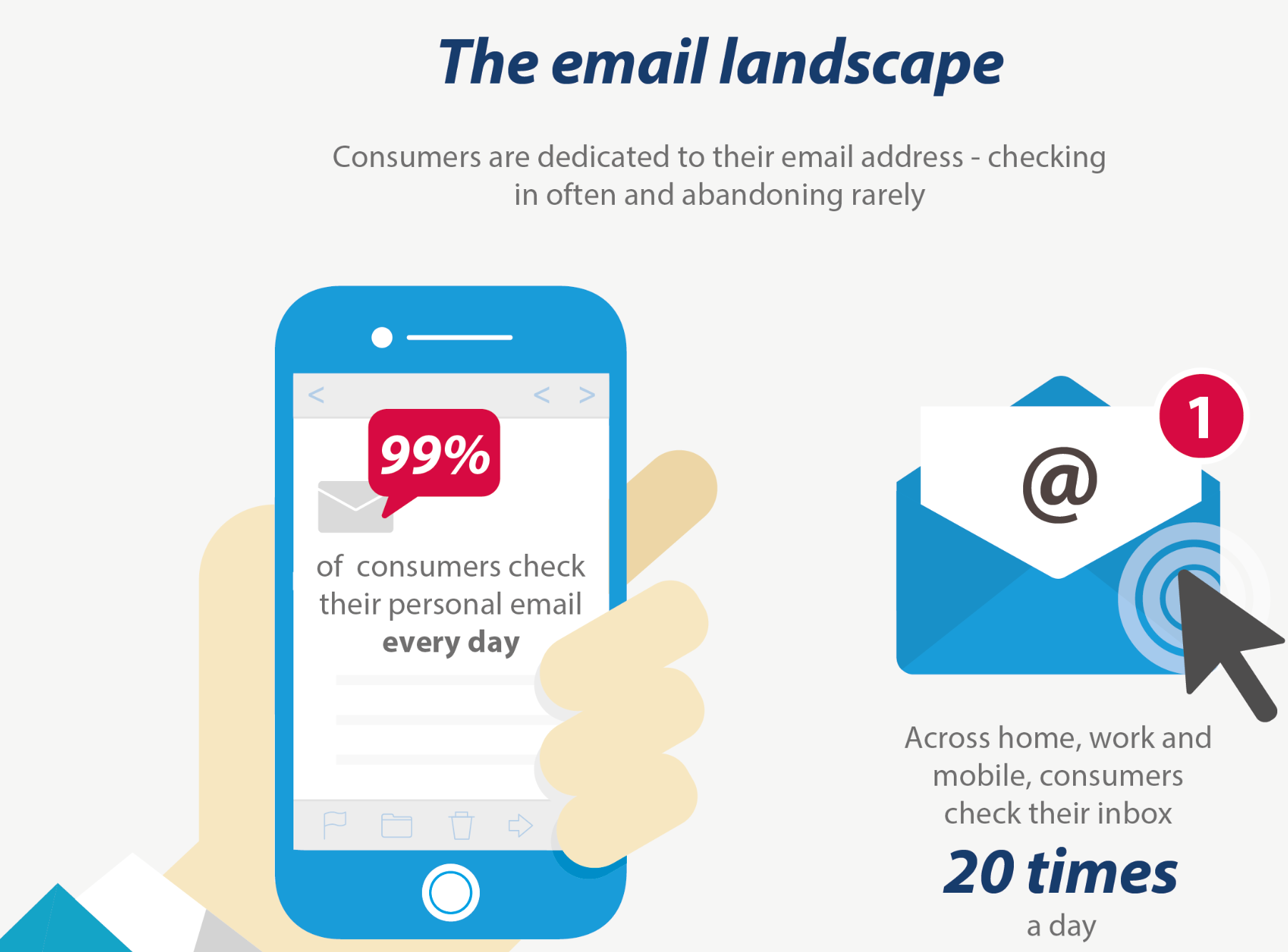
Adestra says people like getting high value emails from businesses: more than 50% of people sign up to get coupons.
Email is a great way to build a personal connection with potential customers. To use email marketing effectively, you must:
- Have a place where people can sign up for emails, such as your header or sidebar
- Offer an incentive to sweeten the deal – a coupon or a lead magnet (a digital resource you offer in exchange for an email address)
- Email prospects regularly with information to help them learn more about you and help them solve their problems
- Personalize your emails
Lead Magnets
One excellent lead-generation tool is a lead magnet, a resource you offer in exchange for an email. Ideally, this resource is useful and actionable for your audience. It’s not about the hard sell; it’s about tempting your audience to engage more.
As well as ebooks, you can use checklists and worksheets as lead magnets. You can also use webinars, free trials, and gated content. This is where you hide part of a high-value piece of content and reveal it in exchange for an email address.
HubSpot is one of our favorite lead generation examples. It incorporates much of the advice we’re sharing in this guide. The company has grown its business by giving away a lot of content for free. The company:
- Collects information by offering free tools
- Uses email marketing to send out information
- Collects more information in exchange for lead magnet ebooks
- Tweaks offers based on what visitors have already seen, interacted with or downloaded
The company’s top lead magnet of 2017 was a video that was shared more than 12,000 times.

You can also segment your email list by doing in-email quick surveys, or by getting people to go to a page and indicate their interests. This lets you target your lead generation efforts more effectively. Here are some more tactics for growing your email list.
Social Media
The content you create can also help you generate leads via social media. Social media is a lead-generation strategy you can’t ignore.
According to We are Social, the number of active social media users has risen 8.6% in the last year to 4.43 billion.
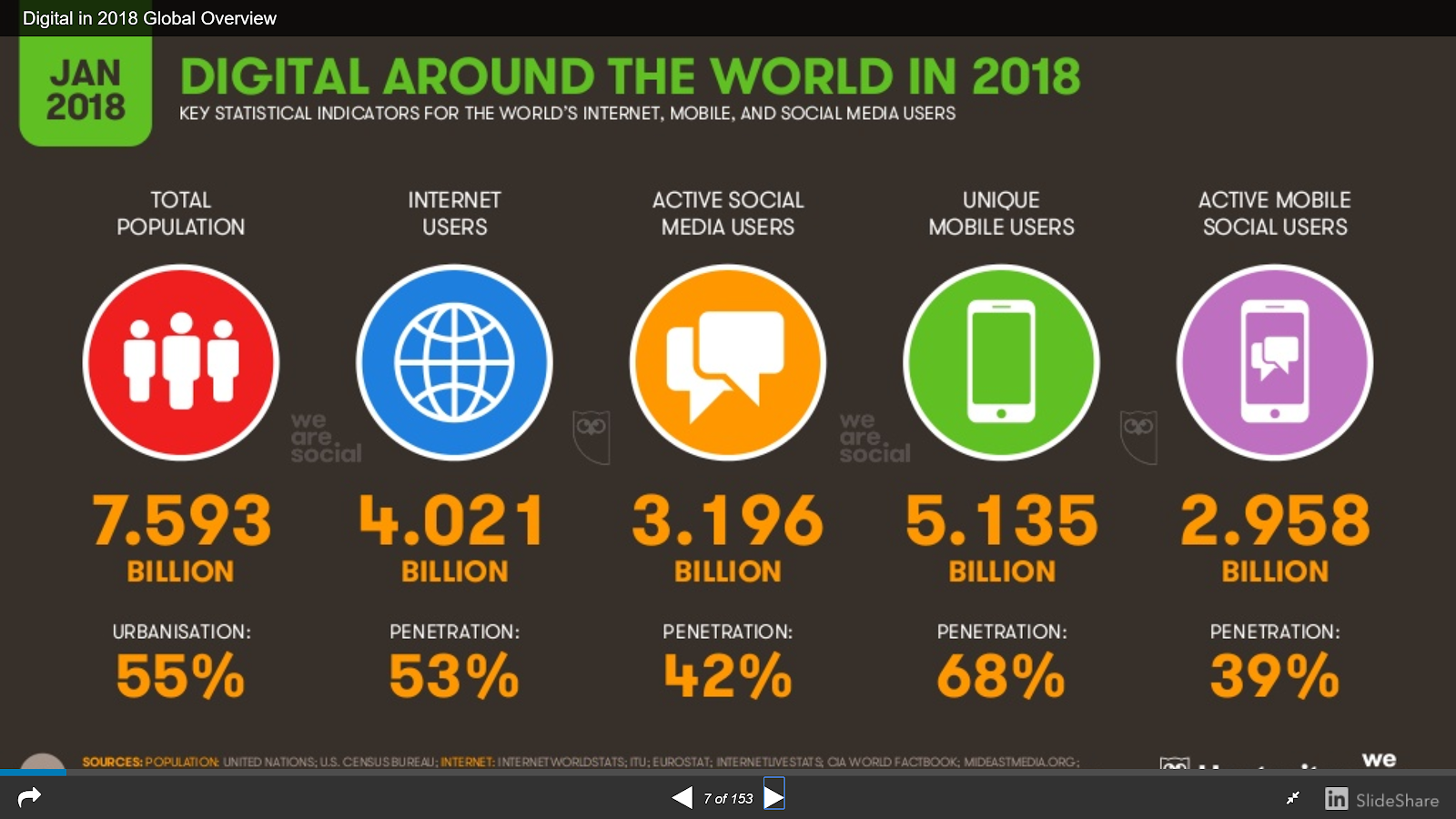
To use your content for social media lead generation, you first have to figure out where your audience is hanging out and what they’re doing. Use the analytics built into social media platforms to figure out what’s popular or trending in your niche, and then see where there’s a match between your audience’s needs and the content you have to share.
Once you have this information, you can generate leads via:
- Sharing content as you publish it
- Extracting pieces of content to create graphics
- Running contests or quizzes
- Publishing teasers for lead magnets
- Responding quickly to questions and comments
- Paying to promote popular social content for more reach
Lead Generation Strategies
In the previous section, we shared a good overview of how to create buyer personas and increase online leads in your sales and marketing funnel. Now, we will expand on these ideas and delve into specific strategies to consider adding to your lead generation marketing strategies.
How to Generate Leads with Digital Advertising
Advertising is far from dead. It’s simply evolved. More often than not, the age-old practice of simple interruption or distraction has given way to presenting ads more in line with the prospect’s needs. Technology makes possible the data-driven approach that evaded us in decades past.
Let’s look at some of the paid-marketing strategies brands use for online lead generation:
1. Search engine advertising
While the pay-per-click (PPC) model applies to various ad types, search engine advertising remains its most popular form and Google’s still its revenue champion.
Running search engine ads is a way of buying visits to your site. As an advertiser, you bid for placements on the search engine results pages (SERPs) when someone searches for a relevant term.
For example, a quick search for “marketing tools” reveals ads from companies like Bronto, PWC, Capterra and SurveyMonkey.
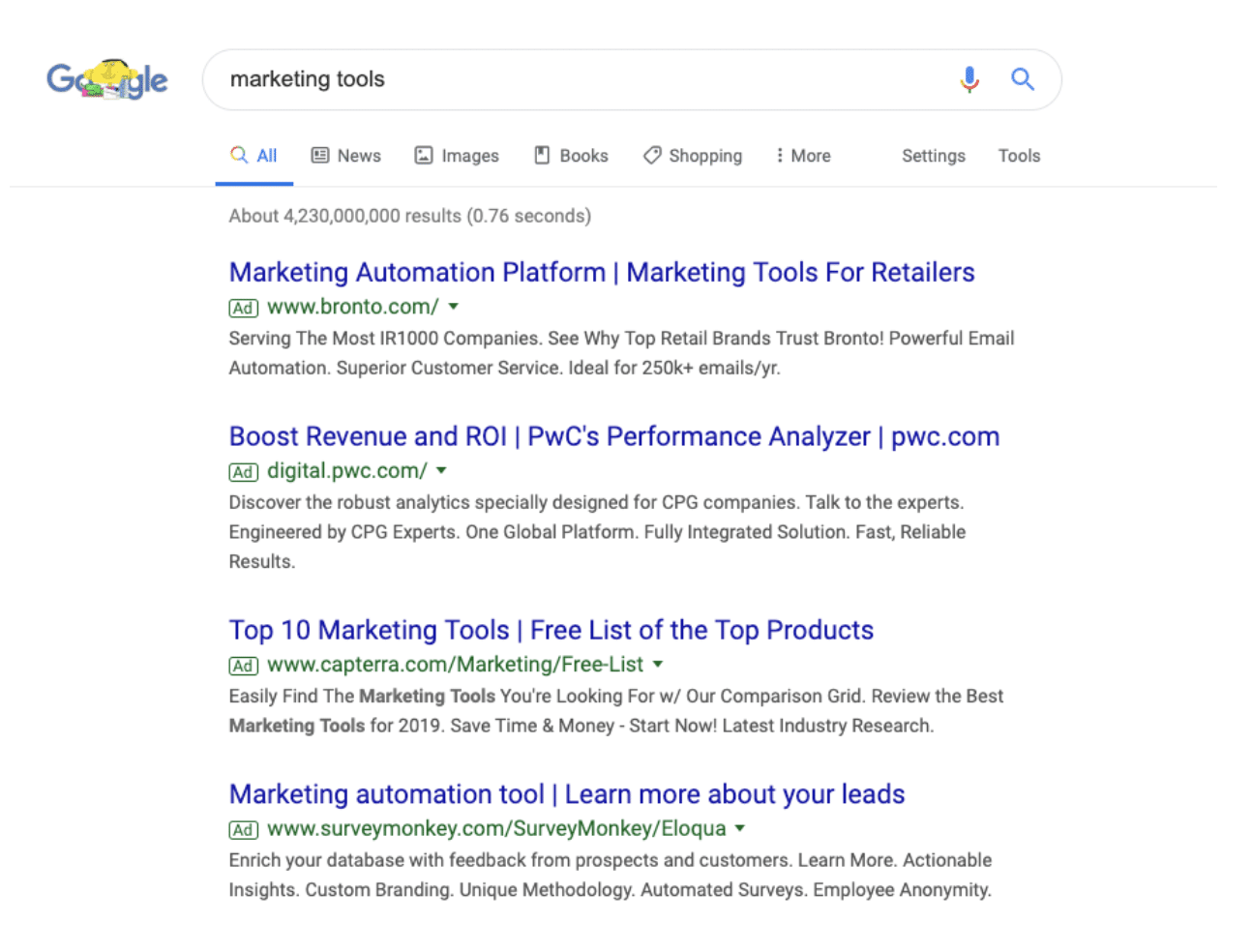
2. Social media advertising
Facebook dominates social media advertising and many brands deem it a necessity for reaching followers with any degree of predictability. Of course, Instagram (a Facebook company) LinkedIn, Twitter, YouTube (a Google company), Pinterest and many others offer social media ad programs. Social media ads take many forms and the programs perpetually evolve. Like search, social media advertising is often based on a PPC model.
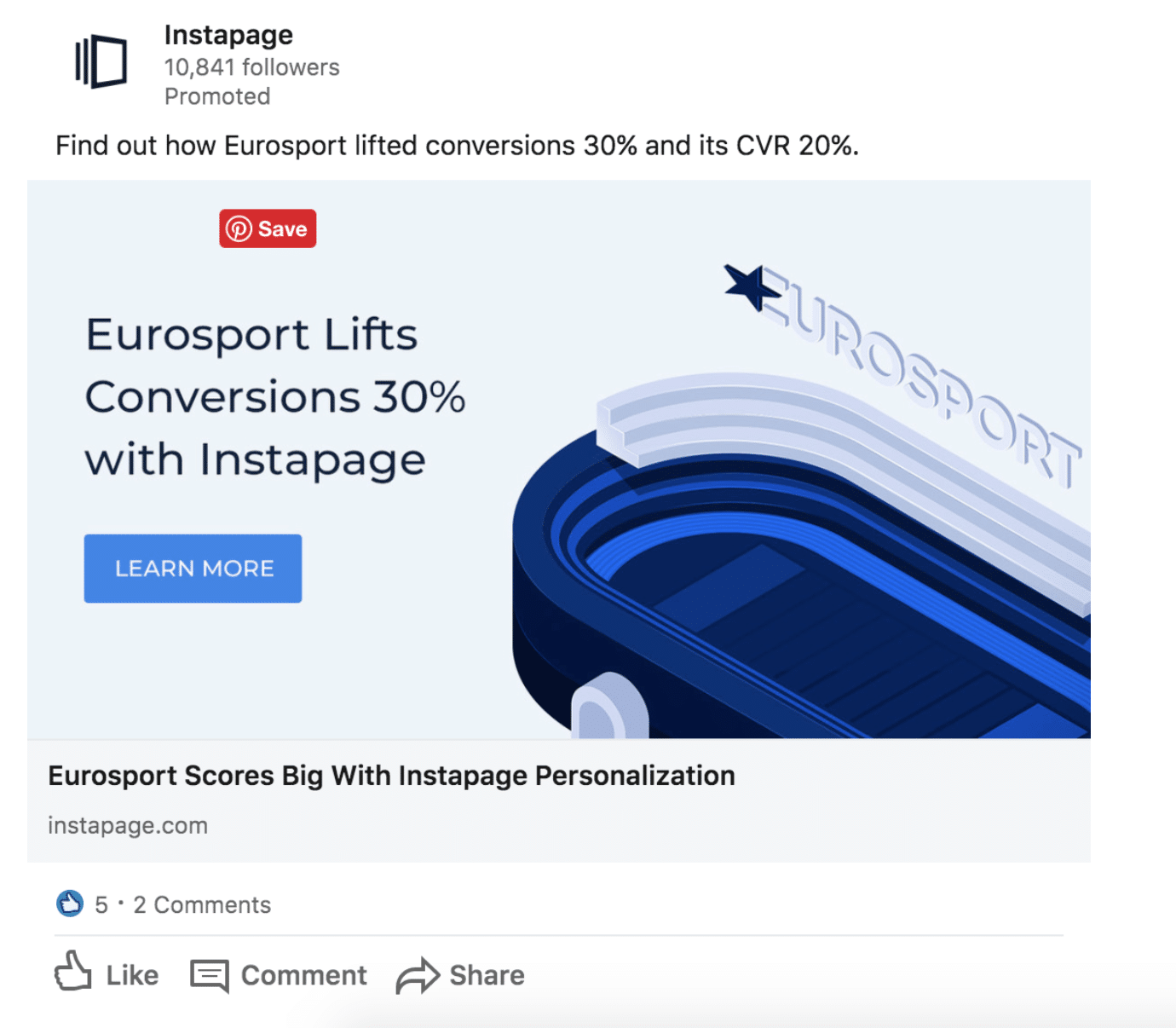
The Instapage ad above is an example of a social media ad targeting online marketers via LinkedIn.
Social media ads take many forms and the programs perpetually evolve. Like search, social media advertising is often based on a PPC model.
3. Native advertising
The online dictionary says: “native advertising is blurring the lines between advertising and content.” Native advertising is a form of paid media where the ad experience follows the form and function of the medium on which the ads reside.
Native advertising takes many forms, including search engine advertising and social media advertising. Native advertising is also a powerful play beyond the ‘walled gardens’ of Google, Facebook, etc. and affords advertisers greater scalability.
4. Discovery
Discovery ads are the native ad form that fuels Taboola’s business. Discovery ads showcase brands and the content they offer on publishers’ websites.
Labeled ‘sponsored’ or ‘recommended,’ they commonly appear below, beside or within articles . They do not resemble traditional banners and generally include a single image, title and brand name (but no logo).
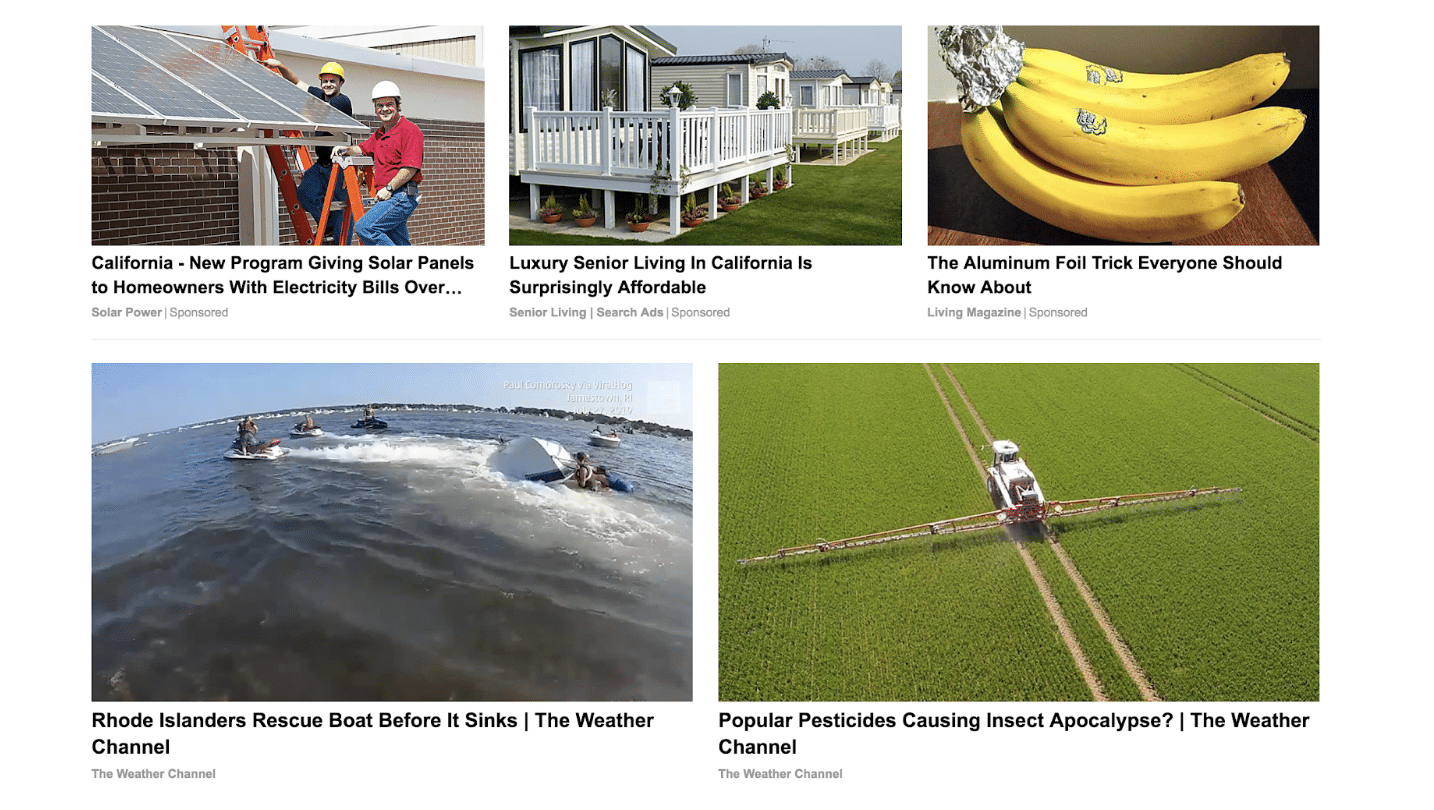
Above is a glimpse of a section of the Taboola feeds on The Weather Channel. Promoted content includes advertisers and additional pages on The Weather Channel site.
5. Sponsored content
Sponsored content is another type of native advertising found on media sites. The ad —and the content it links to (usually long-form) — is generally created via a collaboration between the advertiser and the host publisher.
For example, Forbes’ brand voice portal is home to many sponsored articles, like this one from gradsoflife.org:
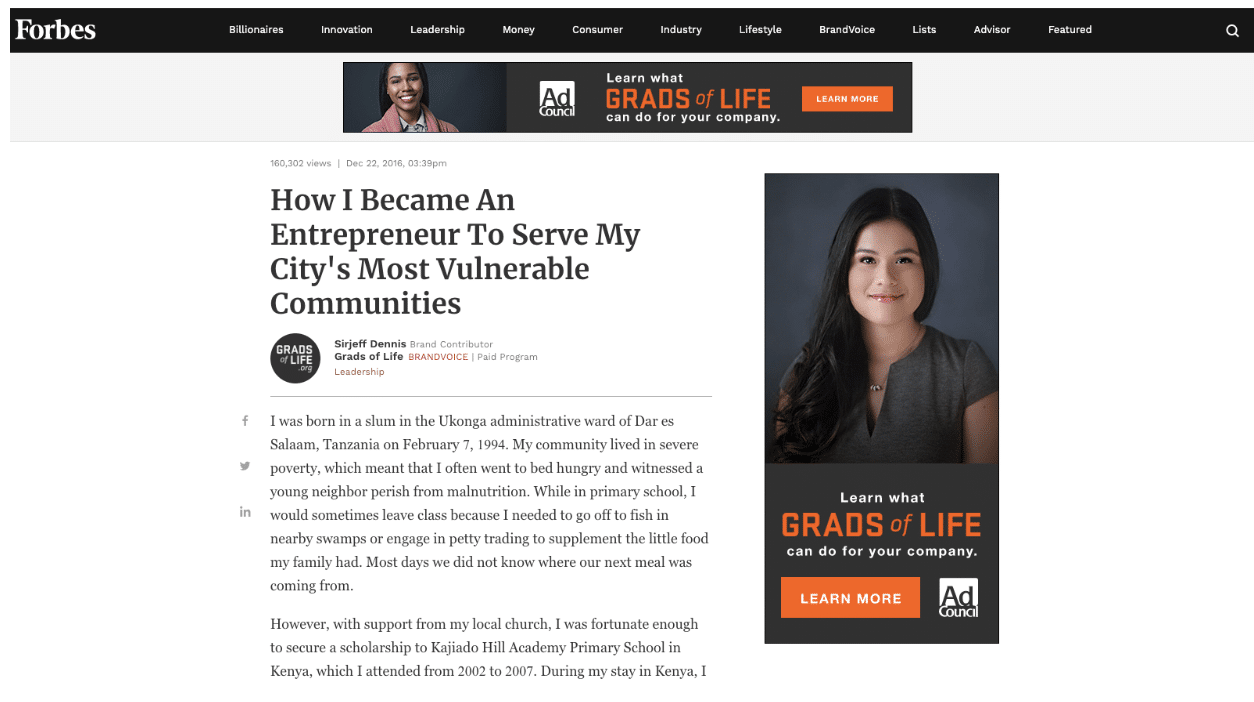
Sponsored content takes many forms including articles, videos and reports. It usually focuses on educating the prospect.
6. Retargeting
Retargeting (or remarketing) ads are not necessarily native; they often take the form of the digital display ads that have populated the web since the 1990s.
Retargeting ad programs track people who visit your site and later display your ads to them as they visit other sites. For obvious reasons, retargeting ads often prominently feature an offer.
For example, Otty‘s Taboola retargeting campaigns generating 10x the results of those that weren’t using retargeting—they did so by simply retargeting previous site visitors that hadn’t taken action before.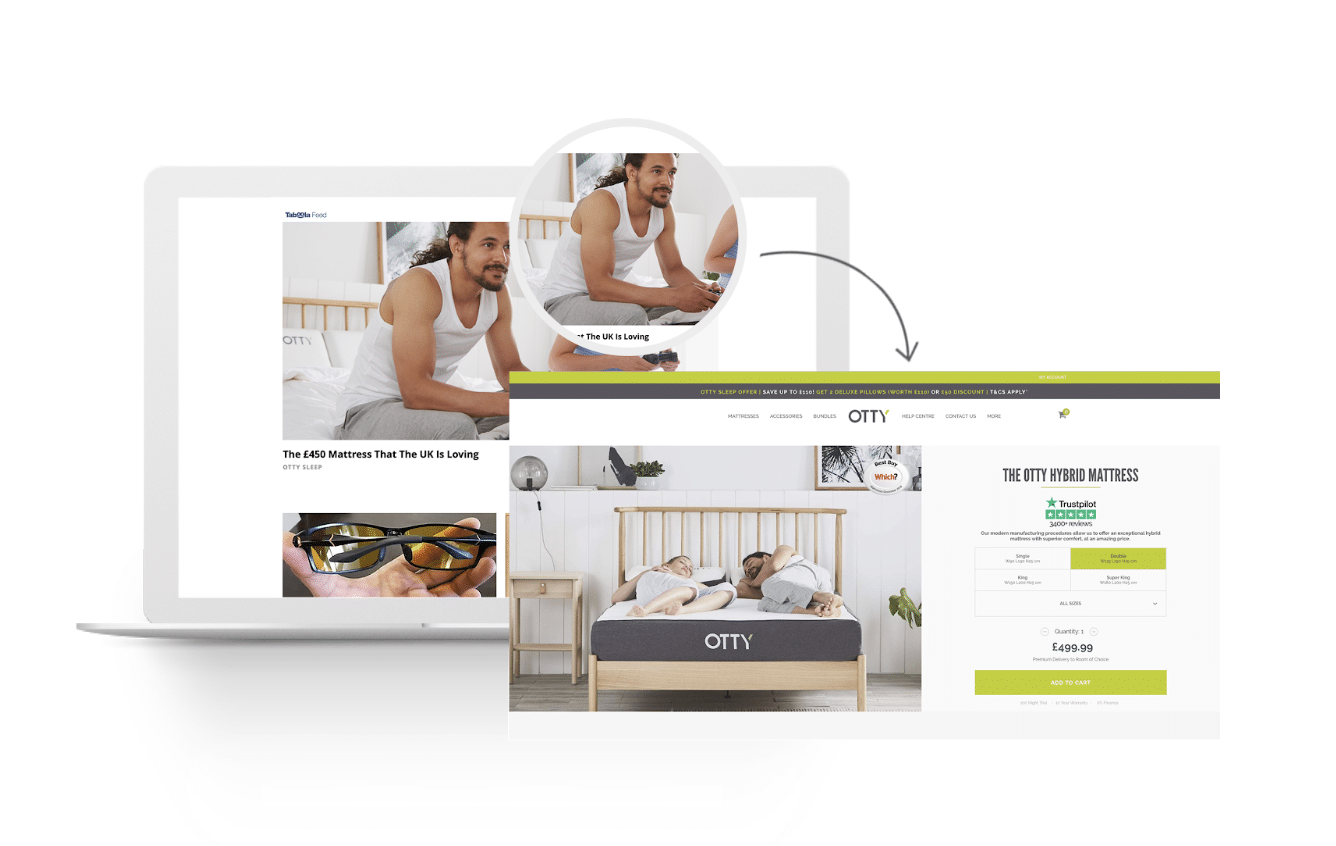
Generate leads online with content
Digital marketing affords you a great many opportunities to generate traffic organically and convert visitors to leads, by offering various types of content potential buyers will value.
‘Lead magnets’ is the moniker often attached to free content assets that require a prospect to opt-in to your email list as the price of admission. So, next we’ll examine online lead generation strategies that aim to convert a visitor to a subscriber.
7. Blog
A blog is the grandmaster of all content-marketing strategies. Only in rare cases would admission to your blog require a visitor to fill out a form, however, your company’s blog is the home to articles, images, video, audio or any digital assets that might inspire a visitor to become a prospect.
Think of your blog as a gateway to lead generation. Done well, a blog can also:
- Position your company and people as subject matter experts
- Earn search engine rankings
- Inspire a dialogue with prospects
8. Big content
I wish I had a better name for this one, but big content will have to do. Your big content might be industry research reports, educational eBooks, online courses, a series of videos, and more. The key here is to offer content that is free, but so valuable that many might pay for it if asked to do so.

It’s fair to qualify the report offered in the squeeze page above as ‘big content.’ As you see here, Salesforce offers a robust industry research report at no cost.
9. Video
Video is sometimes gated. This means a form will be a part of the process by which a prospect gains access to your content.
A 60-second explainer video (a commercial, basically) should not require a form fill, however, various types of educational and/or entertaining videos are perfect for online lead generation.
10. Webinars
Though they require a good deal of planning, preparation and promotion, webinars are one of today’s best online lead generation strategies, especially for B2B marketing.
Effective webinars tend to focus on specific problems and challenges people face. They can also add a degree of interactivity to increase engagement. Recorded webinars become an evergreen asset and repurposed webinar content can support a variety of additional lead-generation programs.
11. Coupons and rewards
You can’t discount the power of the discount. In many industries, financial incentives are what most motivates would-be buyers to act. Coupons present the most obvious form of lead generation here, but a number of rewards programs such as discounts, bonus offers, and loyalty programs can work to create leads, generate sales, and customer loyalty.
12. Interactive content
Interactive content is a big and expanding online lead generation strategy. Interactive tactics often include a degree of gamification with promotions such as quizzes, contests and sweepstakes. Tactics, such as assessments, surveys and buying guides, serve to (1) help buyers make informed decisions and (2) deliver customer insights to marketers.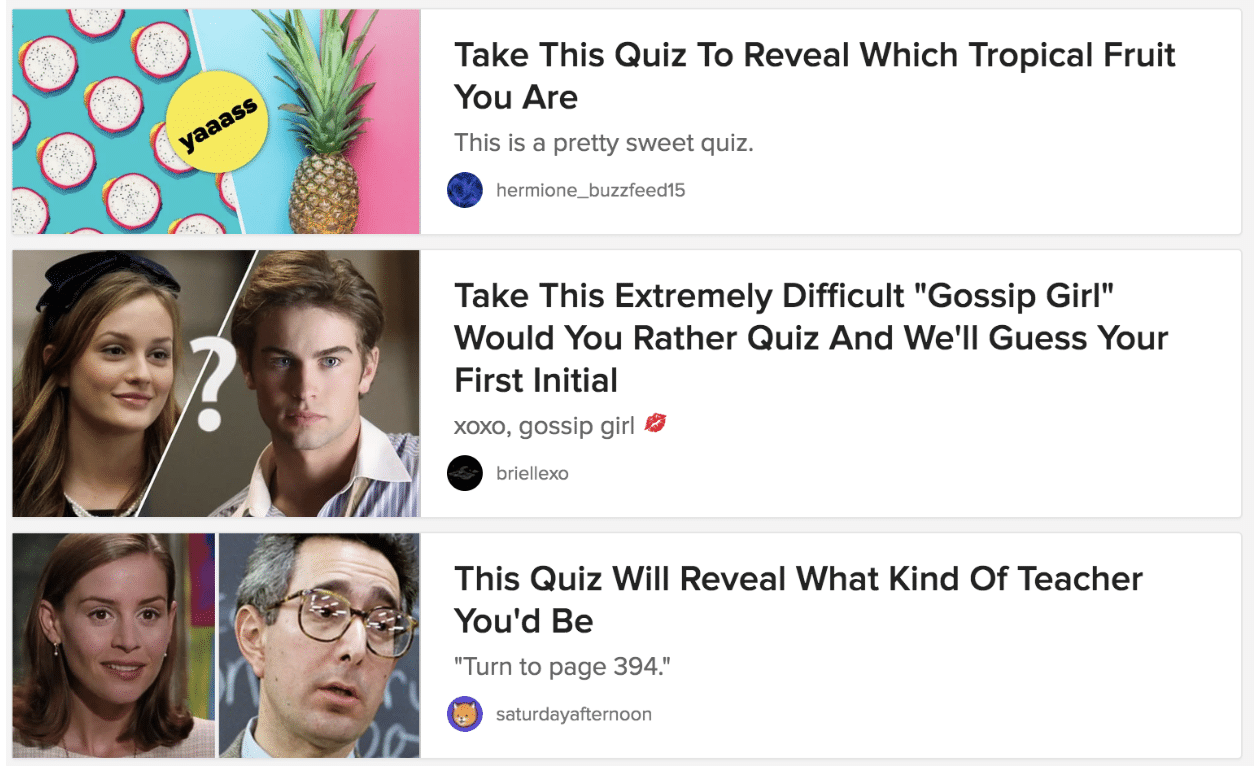
BuzzFeed helped make the interactive quiz a staple of marketing.
13. Tools and apps
Consider extending your interactive content portfolio to include tools and apps that engage and inspire prospects. Calculators, templates, evaluations, and virtual reality (VR) or augmented reality (AR) applications are a few of the tools marketers offer customers aiming to make smart buying decisions.
Make your website a lead generator
‘Owned media’ is a term often associated with digital assets deployed on your website and blog where you have complete control.
14. Landing page
While a landing page resides on your domain, it should function differently to a standard web page and focus on a specific offer with a singular call-to-action. Landing pages often serve as the gateway to delivering an offer associated with a digital ad or any type of lead generation element that appears somewhere other than your website.
The style and content of landing pages differs greatly, but the common denominator is they focus on converting the visitor with the use of a form or sales mechanism.
This one from Casper clearly indicates the one action they want site visitors to do—shop.
15. Pop-ups
Pop-ups get a bad rap as marketers often feel they detract from the user experience and chase customers away. The truth, however, is pop-ups can increase conversion.
If you’re new to using pop-ups on your website, experiment with the options pop-ups offer, such as interstitials, exit-intent, slide-ins, and the like. Many of the services that enable you to deploy pop-ups on your site offer options to change the timing, frequency, and pages on which your pop-ups appear and may enable you to A/B test your tactics.
Try different approaches and closely monitor conversion metrics to find a fit for your audience aligned to your marketing objectives.
16. Chat
Chat is growing in popularity. Most customers would rather chat than call or email. Employ chat services manned by live agents, automate the exchanges, or a combination of both.
This example from SoBo stylist shows how you can use a chatbot to do things like book appointments with potential consumers.

While chat first caught on as a customer service feature, it’s now widely used to engage first-time visitors and help them find the answers they seek.
Earn leads by increasing your digital footprint
Let’s look at offsite lead-generation strategies that don’t depend on buying media. I like to refer to the idea of ‘earning’ media as an exercise in increasing your digital footprint.
17. Organic search
In this era of continuous and nearly ubiquitous connectivity, most buying exercises begin with search.
As such, generating traffic via organic search is all-important to global, regional or local businesses. Any business serious about generating leads must develop some understanding of search engine optimization (SEO). While dominating search engine results is a complex undertaking, the process of indicating to the search engines your page is relevant to a specific search term, or keyword, is a simple process.
18. Social media
As younger generations expand and seize the largest chunk of the workforce and consumer buying power, social media is vital for your brand.
Does this mean you must make yourself known across every social network? No. Your social media marketing strategy should focus on identifying where your potential customers are active and what types of content gets them to click, comment, and share.
19. Q&A sites and forums
Question and answer sites, such as Quora, are another form of social media where your brand can raise its presence, deliver value and generate leads.
Forums too – be they groups on social media, industry specific exchanges, or forum-based sites such as Reddit— attract people with like-minded interests in pursuit of solutions to the challenges they face at work and in their lives.
20. Guest blogging and syndication
Q: What’s a brand to do when it struggles to build its audience on its blog or website? A: Get published on sites that already have a big (or highly-focused) audience.
This is guest blogging. As part of your larger lead generation strategy, guest blogging can boost reach to target markets, elevate authority, secure backlinks to your site, and capture new sources of traffic likely to subscribe to your blog and/or explore what your website and company offers.
21. PR
PR works in tandem with paid advertising, content marketing, events, and a variety of marketing tactics both online and off to generate traffic and leads. Editorial placements earned through PR also help increase conversion rates by winning credible, third-party endorsements.
What Does it Mean to Qualify a Lead?
Qualifying a lead means determining whether or not the person with interest in your product or service is a prospective customer.
Once a lead is qualified, they are ready to move forward in the marketing-sales funnel and engage with sales, as there is a high chance they will make a purchase.
How to Qualify a Lead
There are several ways to qualify a lead to determine if they are a prospective customer. Those include:
1. Investigate how they engage with your website
When this lead is on your website or engaging with your content, are they downloading materials, reviewing pricing information, or requesting product demos or additional product information? This indicates that they may be more likely to make a purchase, as they’re expending effort and likely personal information to learn more about purchasing your product or service.
2. Use your buyer personas
A lead fitting into one of your target buyer personas doesn’t automatically make them qualified, but it certainly indicates the possibility. Look further into it, and lean on the work you’ve done creating buyer personas to guide the way for determining who is a qualified lead and who might not be.
3. Identify decision makers
If your product or service is B2B, ensure that you’re moving decision makers forward into the sales process, rather than someone from their company who may be helping make the decision but won’t ultimately make the purchase. A decision maker is more likely to be a qualified lead than someone who isn’t able to make purchase decisions.
4. Consider email engagement
You may know that someone is a lead because they gave you their email address, but the difference between them being qualified and unqualified lies in engagement. Are they opening your emails? Clicking on links? This kind of information indicates intent, rather than just pure interest.
5. Keep an eye out for red flags
Your time and your team’s time are valuable, and you don’t want to put work into leads who are not only unqualified, but potentially spammy. If the information filled out in forms or via emails you have received don’t seem right, trust your gut––that lead may be unqualified.
Measuring Success
How do you know if your lead generation strategies are working? It’s essential to track metrics, and not all of these are about bottom line sales. Remember, your lead generation process starts with raising awareness. Look at metrics, such as increased traffic to your site or social profiles, and growth in engaged followers.
Next, check out how many people are signing up for your email list, grabbing your lead magnet, or clicking a link in an email to take the next step.
Finally, see how many people sign up for one of your pre-sales webinars or visit a page you know leads to sales. All of this will tell you if your lead generation efforts are working.
That’s it! In this guide, we’ve explained how lead generation links marketing and sales. We’ve explored key lead-generation tactics, such as content marketing, email marketing and social media marketing, and we’ve looked at how to improve lead generation with SEO, SEM and lead magnets. It’s over to you to put these tactics to work, and get more leads for your business.
Learn More
To learn more about lead generation, read our guides to:
- How to Generate Leads – tips and techniques for online-lead generation for B2B, real estate, small business, insurance, financial advisors and mortgage brokers
- Lead Generation Strategies – the proven techniques that generate leads in multiple business sectors
- Lead Generation Campaigns – our pick of the most effective campaigns we’ve seen for lead generation
- Lead Generation Examples – the best examples of lead generation we’ve seen to inspire your own ‘lead gen’ strategy
- Lead Generation Tools – our recommended tools to help you acquire more leads for your business
- Lead Generation Strategies for Financial Advisors – these are strategies you should work with to increase lead generation as a financial advisor